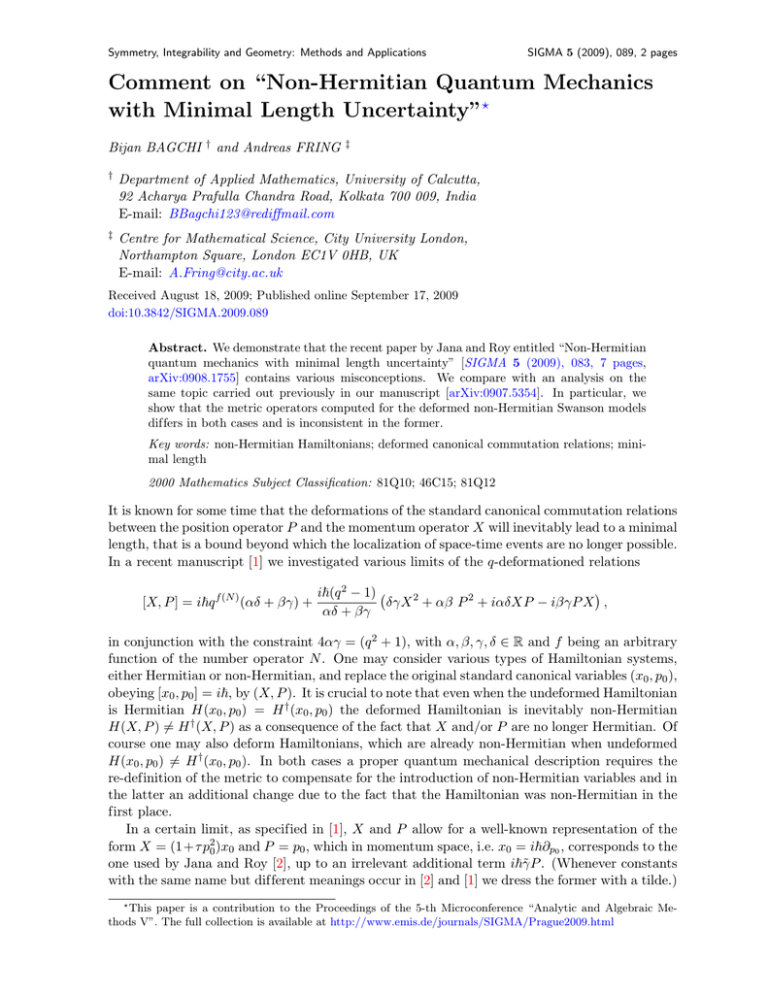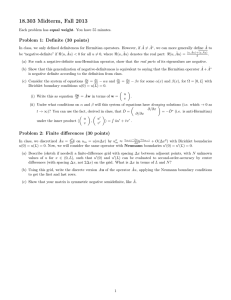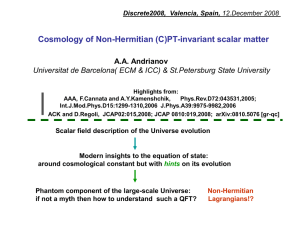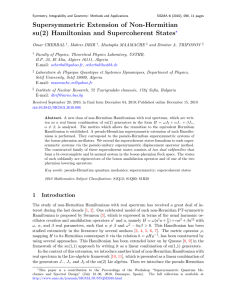Comment on “Non-Hermitian Quantum Mechanics y” ?
advertisement

Symmetry, Integrability and Geometry: Methods and Applications
SIGMA 5 (2009), 089, 2 pages
Comment on “Non-Hermitian Quantum Mechanics
with Minimal Length Uncertainty”?
Bijan BAGCHI
†
and Andreas FRING
‡
†
Department of Applied Mathematics, University of Calcutta,
92 Acharya Prafulla Chandra Road, Kolkata 700 009, India
E-mail: BBagchi123@rediffmail.com
‡
Centre for Mathematical Science, City University London,
Northampton Square, London EC1V 0HB, UK
E-mail: A.Fring@city.ac.uk
Received August 18, 2009; Published online September 17, 2009
doi:10.3842/SIGMA.2009.089
Abstract. We demonstrate that the recent paper by Jana and Roy entitled “Non-Hermitian
quantum mechanics with minimal length uncertainty” [SIGMA 5 (2009), 083, 7 pages,
arXiv:0908.1755] contains various misconceptions. We compare with an analysis on the
same topic carried out previously in our manuscript [arXiv:0907.5354]. In particular, we
show that the metric operators computed for the deformed non-Hermitian Swanson models
differs in both cases and is inconsistent in the former.
Key words: non-Hermitian Hamiltonians; deformed canonical commutation relations; minimal length
2000 Mathematics Subject Classification: 81Q10; 46C15; 81Q12
It is known for some time that the deformations of the standard canonical commutation relations
between the position operator P and the momentum operator X will inevitably lead to a minimal
length, that is a bound beyond which the localization of space-time events are no longer possible.
In a recent manuscript [1] we investigated various limits of the q-deformationed relations
[X, P ] = i~q f (N ) (αδ + βγ) +
i~(q 2 − 1)
δγX 2 + αβ P 2 + iαδXP − iβγP X ,
αδ + βγ
in conjunction with the constraint 4αγ = (q 2 + 1), with α, β, γ, δ ∈ R and f being an arbitrary
function of the number operator N . One may consider various types of Hamiltonian systems,
either Hermitian or non-Hermitian, and replace the original standard canonical variables (x0 , p0 ),
obeying [x0 , p0 ] = i~, by (X, P ). It is crucial to note that even when the undeformed Hamiltonian
is Hermitian H(x0 , p0 ) = H † (x0 , p0 ) the deformed Hamiltonian is inevitably non-Hermitian
H(X, P ) 6= H † (X, P ) as a consequence of the fact that X and/or P are no longer Hermitian. Of
course one may also deform Hamiltonians, which are already non-Hermitian when undeformed
H(x0 , p0 ) 6= H † (x0 , p0 ). In both cases a proper quantum mechanical description requires the
re-definition of the metric to compensate for the introduction of non-Hermitian variables and in
the latter an additional change due to the fact that the Hamiltonian was non-Hermitian in the
first place.
In a certain limit, as specified in [1], X and P allow for a well-known representation of the
form X = (1+τ p20 )x0 and P = p0 , which in momentum space, i.e. x0 = i~∂p0 , corresponds to the
one used by Jana and Roy [2], up to an irrelevant additional term i~γ̃P . (Whenever constants
with the same name but different meanings occur in [2] and [1] we dress the former with a tilde.)
?
This paper is a contribution to the Proceedings of the 5-th Microconference “Analytic and Algebraic Methods V”. The full collection is available at http://www.emis.de/journals/SIGMA/Prague2009.html
2
B. Bagchi and A. Fring
The additional term can simply be gauged away and has no physical significance. Jana and Roy
have studied the non-Hermitian displaced harmonic oscillator and the Swanson model. As we
have previously also investigated the latter in [1], we shall comment on the differences. The
conventions in [2] are
HJR (a, a† ) = ωa† a + λa2 + δ̃(a† )2 +
ω
2
√
√
with λ 6= δ̃ ∈ R and a = (P − iωX)/ 2m~ω, a† = (P + iωX)/ 2m~ω, whereas in [1] we used
HBF (X, P ) =
P2
mω 2 2
+
X + iµ{X, P }
2m
2
with µ ∈ R as a starting point. Setting ~ = m = 1 it is easy to see that the models coincide when
λ = −δ̃ and µ = δ̃ − λ. The Hamiltonians exhibit a “twofold” non-Hermiticity, one resulting
from the fact that when λ 6= δ̃ even the undeformed Hamiltonian is non-Hermitian and the other
resulting from the replacement of the Hermitian variables (x0 , p0 ) by (X, P ). The factor of the
metric operator to compensate for the non-Hermiticity of X coincides in both cases, but the
factor which is required due to the non-Hermitian nature of the undeformed case differs in both
cases
ρBF = e2µP
2
µ
and
ρJR = (1 + τ P 2 ) ω2 τ .
We have made the above identifications such that HJR (a, a† ) = HBF (X, P ) and replaced the
deformation parameter β used in [2] by τ employed in [1]. It is well known that when given only
a non-Hermitian Hamiltonian, the metric operator can not be uniquely determined. However,
as argued in [1] with the specification of the observable X, which coincides in [2] and [1], the
outcome is unique and we can therefore directly compare ρBF and ρJR . The limit τ → 0 reduces
the deformed Hamiltonian HJR = HBF to the standard Swanson Hamiltonian, such that ρJR
and ρBF should acquire the form of a previously constructed metric operator. This is indeed the
case for ρBF , but not for ρJR . In fact it is unclear how to carry out this limit for ρJR and we
therefore conclude that the metric ρJR is incorrect.
References
[1] Bagchi B., Fring A., Minimal length in quantum mechanics and non-Hermitian Hamiltonian systems,
arXiv:0907.5354.
[2] Jana T.K., Roy P., Non-Hermitian quantum mechanics with minimal length uncertainty, SIGMA 5 (2009),
083, 7 pages, arXiv:0908.1755.








